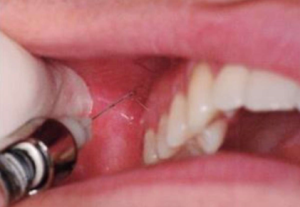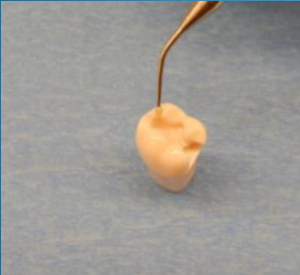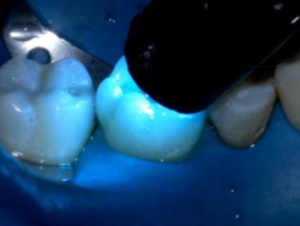Glass ionomer fillings (GICs) are a type of dental filling that plays a special role in modern dentistry due to their unique properties and versatility. Developed in the late 20th century, these fillings have been extensively used for their compatibility with the human body and ability to release fluoride, allowing it to have the added benefit of further protecting the tooth. Let’s take a look at glass ionomer fillings:
What is a Glass Ionomer Filling?

A glass ionomer filling is a type of dental filling material made from a combination of glass and an organic acid. This material is used to fill cavities and repair decayed teeth. It is known for its ability to release fluoride, which helps in preventing further tooth decay. The two materials in glass ionomer fillings are:
- Fluoroaluminosilicate Glass: Provides strength and releases fluoride.
- Polyalkenoic Acid: Reacts with the glass to form a durable solid in the mouth.
Benefits of Glass Ionomer Fillings
Glass ionomer fillings offer several advantages, including:
- Safe to Use: These materials don’t irritate the mouth and gums and are safe for most people.
- Protection Against Future Cavities: Glass ionomer fillings release fluoride over time, helping to keep teeth healthy. This is by far the biggest advantage of glass ionomer fillings and the reason they are used in patients prone to cavities.
- Easy Bonding: Glass ionomer fillings stick to your teeth without needing extra chemicals. This makes it easier for dentists to mix and apply and less likely for mistakes to be made.
- Minimal Stress: These fillings can handle temperature changes well, reducing the risk of cracks in the future.
Disadvantages of Glass Ionomer Fillings
Despite its benefits, silver amalgam has some drawbacks:
- Initial Acidity: Due to polyalkene acids, these types of fillings start off very acidic, which can irritate the tooth pulp if not used properly. Dentists use a protective layer known as calcium hydroxide in deeper cavities to counteract this.
- Strength: Glass ionomer fillings are not as strong as some other types of fillings, such as amalgam fillings and resin fillings. This means they won’t last as long as other filling materials.
- Moisture Sensitivity: They need an extremely dry environment during placement to set properly.
Steps for Applying Glass Ionomer Fillings
The average time for one filling can range between 30-45 minutes, but additional teeth or cavities in between can take longer depending on size and clinician experience. The steps in the filling procedure generally follow this pattern:
During the Procedure
Local Anesthesia Administration:

During a filling procedure, a patient will first receive local anesthesia in the form of a numbing gel, followed by an injection. This will make sure that they do not feel anything during the procedure.
Removal of Decay:

Following this, the decay will be removed with a high-speed handpiece, which may make noise and involve water and air.
Rubber Dam Placement:

A rubber dam will be placed around the affected tooth to keep it dry and free from saliva during the procedure. Alternatively, if a patient doesn’t like the feel of the rubber dam, a dentist can use cotton rolls to keep the tooth dry.
Mix the Material:

The dentist will mix the correct amount of glass ionomer powder and liquid to create a paste.
Apply the Filling:

The mixed material is carefully placed into the prepared cavity. It is important to ensure that the material covers all areas of the cavity evenly.
Light Curing (Optional):

If using a Resin Modified Glass Ionomer, the dentist will use a special dental curing light to harden the material. This process usually takes about 30 seconds.
Checking Bite

After most dental procedures, the bite should also be checked with a special type of paper to confirm the filling isn’t too big. If the filling is too big, this creates unneeded pressure, which increases the chance of the cavity breaking in the future.
Polishing and Final Checks

Finally, any rough surfaces need to be polished with a smoothing instrument so the new filling doesn’t irritate your tongue. During this step, the dentist will communicate with the patient to make sure that the filling is to their liking and that nothing needs to be changed.
Recovery and Aftercare
If the filling is taken care of properly, it can last many years. The average time a filling lasts depends on the material used – glass ionomer fillings can last between 5-10 years. After receiving a filling, make sure to:
- Brush and floss twice daily
- Schedule regular professional cleanings and exams
- Cut back on sugary snacks and drinks
- Use a fluoride mouthwash
- Wear a nightguard if you have bruxism (teeth grinding)
- Avoid hard, crunchy and sticky foods
- Quit smoking if you are a smoker
Conclusion
Glass ionomer fillings offer a unique blend of benefits that make them invaluable in restorative dentistry. They not only repair teeth but also help prevent future cavities. By understanding their benefits and the steps involved in their application, you can see why they are a popular choice for both dentists and patients.
Disclaimer
The contents of this website, such as text, graphics, images, and other material are for informational purposes only and are not intended to be substituted for professional medical advice, diagnosis, or treatment. Nothing on this website constitutes the practice of medicine, law or any other regulated profession.
No two mouths are the same, and each oral situation is unique. As such, it isn’t possible to give comprehensive advice or diagnose oral conditions based on articles alone. The best way to ensure you’re getting the best dental care possible is to visit a dentist in person for an examination and consultation.
SAVE TIME AND MONEY AT ANY DENTIST

Less dental work is healthier for you. Learn what you can do to minimize the cost of dental procedures and avoid the dentist altogether!

